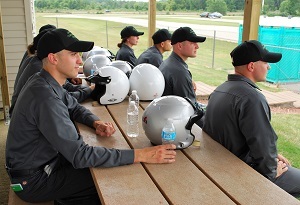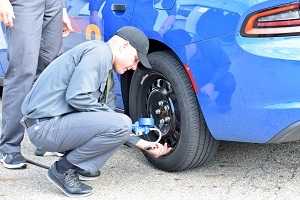Driven to succeed
Week 2: July 23-29, 2017
Week 2 of the Michigan Department of Natural Resources Conservation Officer Recruit School introduced recruits to the basics of precision driving. It was the most adrenaline-pumping, pulse-pounding training the class received to date, as this short video shows.
 As fully commissioned Michigan peace officers, DNR conservation officers must have what it takes to effectively and safely use their patrol vehicles when responding to medical emergencies or crimes in progress and initiating suspect pursuits. Recruits quickly learned that operating law enforcement vehicles requires a lot of skill – and carries tremendous responsibilities. As fully commissioned Michigan peace officers, DNR conservation officers must have what it takes to effectively and safely use their patrol vehicles when responding to medical emergencies or crimes in progress and initiating suspect pursuits. Recruits quickly learned that operating law enforcement vehicles requires a lot of skill – and carries tremendous responsibilities.
Realities of the road
The day’s physical training had a unique twist. Recruits carried canoes filled with water bottles, which simulate the added weight of gear. Conservation officers often use canoes for patrol and getting a canoe to the water often means it must be carried over long distances and obstacles. Incorporating the canoes into the day’s physical training helps recruits build the skills needed to conduct these patrols.
After the morning routine of physical training, breakfast and inspections, recruits on Monday reported to the drive track for an introduction to precision driving. Forget the wild, over-the-top vehicle chases shown on TV crime dramas.
“Driving is extremely important because it’s what officers do more than anything else in the course of their daily duties,” Detective Elton Luce III, emergency vehicle operation instructor, told his class. “It is also one of the largest potential concerns for liability. Most officer-involved traffic crashes happen in normal, routine driving situations, not in pursuits or emergency runs. Police officers are held to a higher standard than civilian drivers, so extensive training is a must.”
Recruits were instructed on legal issues pertaining to the operation of police vehicles. They also were introduced to the Dodge Chargers they will use for their Michigan Commission on Law Enforcement Standards (MCOLES) evaluations. Because conservation officers drive trucks rather than cars, recruits will drive a portion of the course with DNR trucks after earning their 40-hour precision driving certification.
Strong nerves and stomachs
Tuesday’s emergency vehicle operation session was the start of a major test for recruits. They began driving drills that demand an impressive range of knowledge, not to mention strong nerves and stomachs as some of the exercises were  done at high speeds. An understanding of the physics of motion, knowing a vehicle’s capabilities and design, and being able to “read the road” are the foundations of proper emergency vehicle driving techniques. done at high speeds. An understanding of the physics of motion, knowing a vehicle’s capabilities and design, and being able to “read the road” are the foundations of proper emergency vehicle driving techniques.
Conservation officers will be called upon to safely operate a vehicle on all types of terrain, regardless of whether it is day or night, and in all kinds of weather conditions. Their ability to handle such situations is groomed on the academy drive track. Navigating sharp corners, learning when to accelerate and decelerate, and maneuvering between strategically placed cones were among the challenges confronting recruits.
Hitting the skids
On Wednesday recruits hit the skids, but that was by design. The “skid pad” exercise required recruits to maintain control of their vehicles while hydroplaning on a watered-down surface. The class also got to open things up a bit by putting the patrol vehicles through full “hot laps,” in which recruits used all techniques learned earlier in the week to complete the course.
Night driving
After an already full day Thursday, recruits continued with their driving instruction into the evening. The goal was to help them master the necessary skills to pursue suspect vehicles at night. The class found how difficult it is to navigate  the same course with little or no ambient light. The training also emphasized the use of radios. Recruits were required to use their radios to communicate with the dispatch center, a critical skill as conservation officers often work at night. the same course with little or no ambient light. The training also emphasized the use of radios. Recruits were required to use their radios to communicate with the dispatch center, a critical skill as conservation officers often work at night.
Cool down
The written final exam came Friday. Recruits were tested on all topics covered during the week. A lot was learned since they first reported to the drive track Monday. Perhaps the most important lesson is that there’s no place for recklessness behind the wheel. A conservation officer is in total control of his or her vehicle at all times, regardless of how police chases are portrayed by Hollywood.
Unlike their first few days at the academy, week 2 sped by for recruits – literally.
Subscribe to the weekly conservation officer academy blog, which also will be posted on the Michigan DNR Facebook page. View previous blogs from Recruit School #8.
/Note to editors: Accompanying photos are available below for download. Caption information follows.
DNR_truck: Because conservation officers drive trucks rather than cars, recruits use DNR trucks for a portion of the precision driving course after earning their 40-hour precision driving certification.
Taking_it_all_in: Recruits learn the art of precision driving during the third week of the Michigan Department of Natural Resources Conservation Officer Recruit School. In addition to learning all-important driving techniques, recruits were instructed on legal issues pertaining to the operation of law enforcement vehicles.
Pressure_check: A recruit checks the tire pressure on his test vehicle as part of his instruction at the precision driving track. Michigan conservation officers spend significant time in their vehicles and must be able to handle and maintain them effectively and safely, in all types of conditions./
The Michigan Department of Natural Resources is committed to the conservation, protection, management, use and enjoyment of the state’s natural and cultural resources for current and future generations. For more information, go to www.michigan.gov/dnr.
|